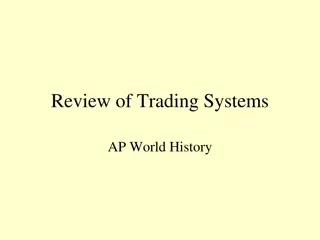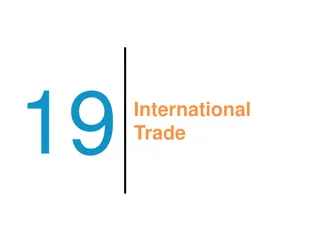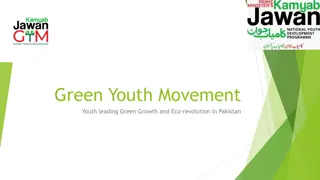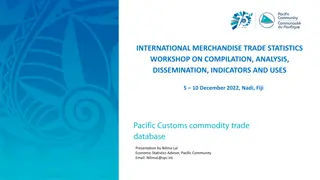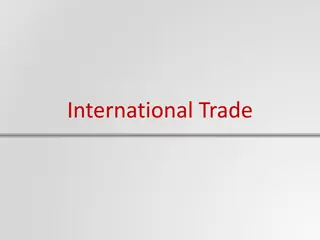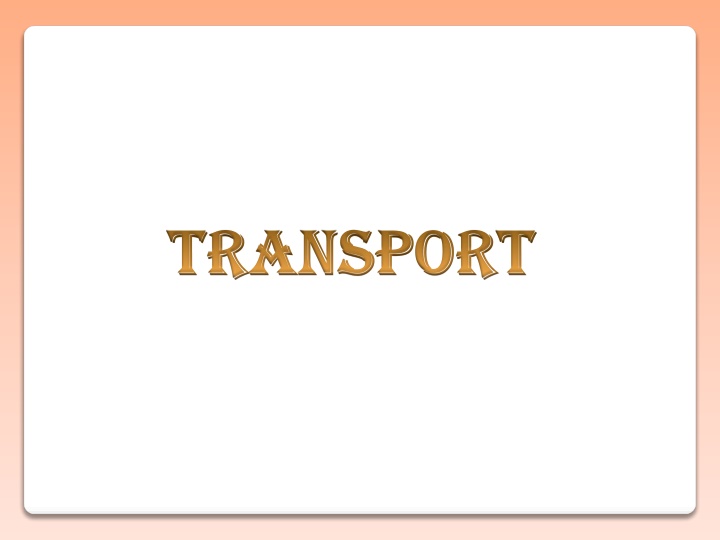
Importance of Transport in Sustained Economic Growth
A well-developed transport system is vital for economic growth, with transport routes serving as economic arteries. In countries like India, the diverse geography makes transport crucial for national integration and progress. The Indian railway system has been a key player in economic and social development, despite facing challenges like safety and financial issues.
Download Presentation

Please find below an Image/Link to download the presentation.
The content on the website is provided AS IS for your information and personal use only. It may not be sold, licensed, or shared on other websites without obtaining consent from the author. If you encounter any issues during the download, it is possible that the publisher has removed the file from their server.
You are allowed to download the files provided on this website for personal or commercial use, subject to the condition that they are used lawfully. All files are the property of their respective owners.
The content on the website is provided AS IS for your information and personal use only. It may not be sold, licensed, or shared on other websites without obtaining consent from the author.
E N D
Presentation Transcript
transport transport
TRANSPORT Role of Transport in the Sustained Economic Role of Transport in the Sustained Economic A well-knit and coordinated system of transport plays an important role in the sustained economic growth of a country. Transport routes are the basic economic arteries of the country. Transport system is regarded as the controller of the national economy and provides a very important link between production and consumption. The amount of traffic moving in a country is a measure of its progress. In a country like India, the importance of transport is more because of its vastness as well as varied nature of geographical conditions. In India, it is also a source of national integration. The present Indian transport system comprises several modes including rail, road, coastal shipping, air transport, etc. Transport has recorded a substantial growth over the years both in terms of length and output of the system. Railways: The railways in India provide the principal mode of transportation for freight and passengers. It brings together people from the farthest corners of the country and makes possible the conduct of business, sightseeing, pilgrimage and education. Indian railways have been a great integrating force during the last 150 years. It has bound the economic life of the country and helped in accelerating the development of industry and agriculture. From a very modest beginning in 1853, when the first train steamed off from Mumbai to Thane, a distance of 34 km, Indian Railways have grown into a vast network of 6,906 stations spread over a route length of 63,122 km with a fleet 7,681 locomotives, 39,852 passenger service vehicles, 4,904 other coachingof vehicles and 2, 14,760 wagons as on 31 March 2003.The growth of Indian Railways in the 150 years of its existence is thus phenomenal. It has played a vital role in the economic, industrial and social development of the country. The network runs multigauge operations extending over 63,122 route-kilometres . Problems of Indian Railways: Although Indian Railways have progressed a lot, both quantitatively and qualitatively, during the last few years, this system is still plagued by a number of problems which require immediate attention. A lot has been done, but a lot more is yet to be done. Some of the major problems faced by the Indian Railways are briefly discussed as under: Safety: Indian Railways have been in the news albeit for wrong reasons. With the rapid increase in passenger and goods traffic, the frequency of train accidents is increasing very fast. This has raised serious doubts in the public mind about safety of Rail travel and the general health of the railway network. There are several factors which are responsible for increasing number of railway accidents; some outstanding being overage tracks, wagons, coaches, bridges and signalling system. According to the Khanna Railways Safety Review Committee Report, nearly 25 per cent of the total railway track in India is overage and is due for replacement. The tracks suffer from fatigue and wear and tear in due course of time, and their replacement should be carried on side by side. In several derailments poor condition of tracks had been found responsible. Modem signalling like panel inter-locking, route relay inter-locking, and centralised traffic control, automatic signalling and multi-aspect colour light signalling, are being progressively introduced
Cost and Revenue Problems: As is the case with most of the government organisations, Indian Railways face chronic financial crisis. The annual rate of increase in cost has overtaken that of revenues during the last few years. A study of Railways finances from 1998 to 2004 reveals that the revenues increased at an average annual rate of 8.7 per cent against the 9.65 per cent average annual growth in costs. In certain years in between, the revenue growth rate did exceed that of cost. But this position was achieved by providing inadequately for replacements and severely controlling the costs. Such a situation has long term implications as it affects the internal generation of resources. Following are the main causes of costs and revenue problems. Slowdown in Revenue Growth: With saturation of trunk routes and low quality of services and reliability, the revenue growth has registered a slowdown. The railways are increasingly becoming a transporter of bulk commodities for public sector (coal, iron ore, food-grains, etc.) and are consistently losing to roadways. Most of the national highways run parallel to railways and are consistently snatching revenues from the railways. Social Burden: Indian Railways have to play a dual role of revenue earning as well as meeting the social obligations. The Expert Group, constituted in December 1998 to study the railway sector, termed it as the split personality . On one hand, the Railways are seen as a commercial organisation and on the other hand, it is treated as a social organisation which must perform its social obligations. The two functions are diametrically opposite and difficult to reconcile. There are several social obligations on the railways which are always running below cost. Suburban passenger services, concessionary travel to certain section of travellers, concessional freight movement of certain commodities, particularly to remote and inaccessible areas like the North-east region, providing rail services to backward regions are some of the outstanding social obligations on the Indian Railways.
ROAD TRANSPORT Road transport or road transportation is a type of transport by using roads. Transport on roads can be roughly grouped into the transportation of goods and transportation of people. In many countries licensing requirements and safety regulations ensure a separation of the two industries. Movement along roads may be by bike or automobile, truck, or by animal such as horse or oxen. Standard networks of roads were adopted by Romans, Persians, Aztec, and other early empires, and may be regarded as a feature of empires. Cargo may be transported by trucking companies, while passengers may be transported via mass transit. Commonly defined features of modern roads include defined lanes and signage. Various classes of road exist, from two-lane local roads with at- grade intersections to controlled-access highways with all cross traffic grade-separated. Problems Inadequate Roads: Roads are bad and inadequate in India. There are 34 km long roads per 100 sq. km area in India while in Japan 270 km and in West Germany 167 km long roads per 100 sq. km area are there. Government should spend more on the development of roads. Heavy Taxes: There is heavy tax burden on motor transport in India. Tax burden per motor vehicle in India is Rs. 3500 while in America it is Rs. 860 and in Britain Rs. 470. This tax burden should be lowered. No proper Maintenance: Roads are not maintained properly in India. Less than 0.1 percent of the national income is spent on the maintenance of roads in India, while in Japan it is 3 percent of the national income. Lack of Co-ordination: There is little co-operation and co- ordination among different states with regard to motor transport. As such, motor transport faces lot of difficulties. The states should pursue a coordinate policy in this matter. Less Roads in Rural Areas: Sixty percent of villages are without roads in India. It adversely affects our agriculture and rural economy. Government should develop roads speedily in rural areas. Lack of Guest Houses: There is lack of guest houses and hotels along the roadside in India. More guest houses should be built along the road sides, so that people may undertake long road journeys easily. Inefficient Management and Services: According to Road Transport Reorganization Committee , 90 per cent of the operators are small operators owning five vehicles or less. Owing to this small number, satisfactory and efficient service is not being provided to the people.
Rising Prices of Petrol/Diesel: Due to high prices of petroleum products and diesel operational costs of road transport are rising and making the mode of transport more costly. Undisciplined Driving and Accidents: Most of the drivers on the roads are unskilled and untrained. They also drink alcohol while driving. As such, road accidents are more frequent in India. Bad Conditions of Road: In India, roads are not well-maintained as there are no timely repairs. It causes discomfort and quick depreciation of vehicles. Solution Some of the other measures useful for road transport planning are: 1. Restrictions on road capacity and traffic speeds, 2. Regulating traffic access to a link or area, 3. Charging for the use of roads on a link, or area basis, 4. Vehicle restraint schemes, 5. Rail rapid transit, 6. Transport coordination, and 7. Public transport improvement,
Air Transport: Air transportation in India made a humble beginning in 1911 when airmail operation commenced over a little distance of 10 km between Allahabad and Naini. The British, French and Dutch introduced air transport in 1929-30. Indian National Airways was formed in 1933. By the end of World War II, major cities like Bombay, Delhi, Calcutta, Karachi and Lahore (now in Pakistan) and some other places were provided with air service. The actual network of air transport has begun only after independence. In 1953, the air transport was nationalised and two corporations were formed: the Air India and Indian Airlines. Indian Airlines is the major domestic air carrier of the country. It operates to 63 domestic stations (including 2 seasonal stations, i.e., Jaisalmer and Puttaparthy) with its wholly owned subsidiary Alliance Air. Indian Airlines also operates to 16 international stations, viz., Bangkok, Singapore, Kuala Lampur, Yangon, Kathmandu, Colombo, Dhaka, Male, Kuwait, Sharjah, Dubai, Fujairah, Ras-al-khaimah, Muscat, Doha and Bahrain. Indian Airlines has a fleet of 57 aircrafts: 7 A-300s, 36 A-320s, 11 B-737s and 3 Dornier-228s including aircraft taken on lease. All B-737s aircraft are being operated by Alliance Air. Advantages of air transport Following are the advantages of air transport High Speed- It is the fastest mode of transport and therefore suitable for carriage of goods over a long distance. It require less time. Quick Service- Air transport provides comfortable, efficient and quick transport services. It is regarded as best mode of transport for transporting perishable goods. No Infrastructure Investment- Air transport does not give emphasis on construction of tracks like railways. As no capital investment in surface track is needed, it is a less costly mode of transport. Easy Access -Air transport is regarded as the only means of transport in those areas which are not easily accessible to other modes of transport. It is therefore accessible to all areas regardless the obstruction of land.
No Physical Barrier -Air transport is free from physical barriers because it follows the shortest and direct routes where seas, mountains and forests do not obstruct. Natural Route- Aircrafts travels to any place without any natural obstacles or barriers because the custom formalities are compiled very quickly. It avoids delay in obtaining clearance. National defence -It plays a significant role in the national defense of the country because modern wars are conducted with the help of aero planes. Airways has a upper hand a destroying the enemy in a short period. Disadvantage of air transport. Inspite of many advantages, air transport has some disadvantage also. Risky -Air transport is the most risky form of transport because a minor accident may put a substantial loss to the goods, passengers and the crew. The chances of accidents are greater in comparison to other modes of transport. Very Costly- Air transport is considered costlier as compare to other mode of transport. The operating cost of aero-planes is higher and it involves a great deal of expenditure on the construction of aerodromes and aircraft. Because of this reason the fare of air transport are high that common people can t afford it. Small Carrying Capacity- The aircrafts have small carrying capacity and therefore these are not suitable for carrying bulky and cheaper goods. The load capacity cannot be increased as it is found in case of rails. Unreliable- Air transport is unreliable as it depends of the weather forecast. Normally if the weather is not certain the flight may got delayed. Huge Investment- Air transport requires huge investment for construction and maintenance of aerodromes. It also requires trained, experienced and skilled personnel which involves a substantial investment.
WATERWAYS Water transportation is the intentional movement of water over large distances. Methods of transportation fall into three categories: aqueducts, which include pipelines, canals, tunnels and bridges container shipment, which includes transport by tank truck, tank car, and tank ship. towing, where a tugboat is used to pull an iceberg or a large water bag along behind it. Due to its weight, transportation of water is very energy intensive. Unless it has the assistance of gravity, a canal or long-distance pipeline will need pumping stations at regular intervals. In this regard, the lower friction levels of the canal make it a more economical solution than the pipeline. Water transportation is also very common along rivers and oceans. Types of Water Transport 1. Inland water transport 2. 2. Ocean water transport. Advantages of Water transport 1. It involves low running cost which makes it the cheapest form of transport system over long distances. 2. Large vessels especially run economically since fuel costs can be spread over greater quantities. Distance does not add greatly to total transport cost. 3. It has the capacity of conveying heavy and bulky cargoes. 4. Water transport has a natural route network which is free to use. This allows flexibility of service, frequency of movement and little congestion (except where water channels are narrow (as in the case of the Straits of Dover). 5. Canals provide good access along their line sides and also encourage the development of industry and commerce. Some towns have grown largely through their connection with canals. For instance, Stour port. 6. It causes relatively little environmental pollution, but sometimes oil discharge from tankers seems to be the major problems to this mode of transportation.
Disadvantages of Water Transport 1. This mode of transportation is very slow compared to road transport hence; it is unsuitable for perishable goods and urgent cargoes. 2. 2. There may be delays at locks and docks, while navigation may be impeded majorly due to poor weather conditions. 3. 3. It is unsuitable for short distance journeys since transhipment is both costly and time consuming. 4. 4. Canals are very expensive to build, maintain and dredge, and also it follows inflexible and circuitous routes. An adequate supply of water may be difficult to obtain and the limited dimensions of barges may be too small for modern requirement. 5. 5. As ships increase, the number of ports capable of receiving oceans carrying vessels is declining; this results in less flexible routes and services for the movement of such commodities as oil. Super-tankers for instance cannot use Suez Canal and large ships can no longer enter most small port except the modern ones which are very few






